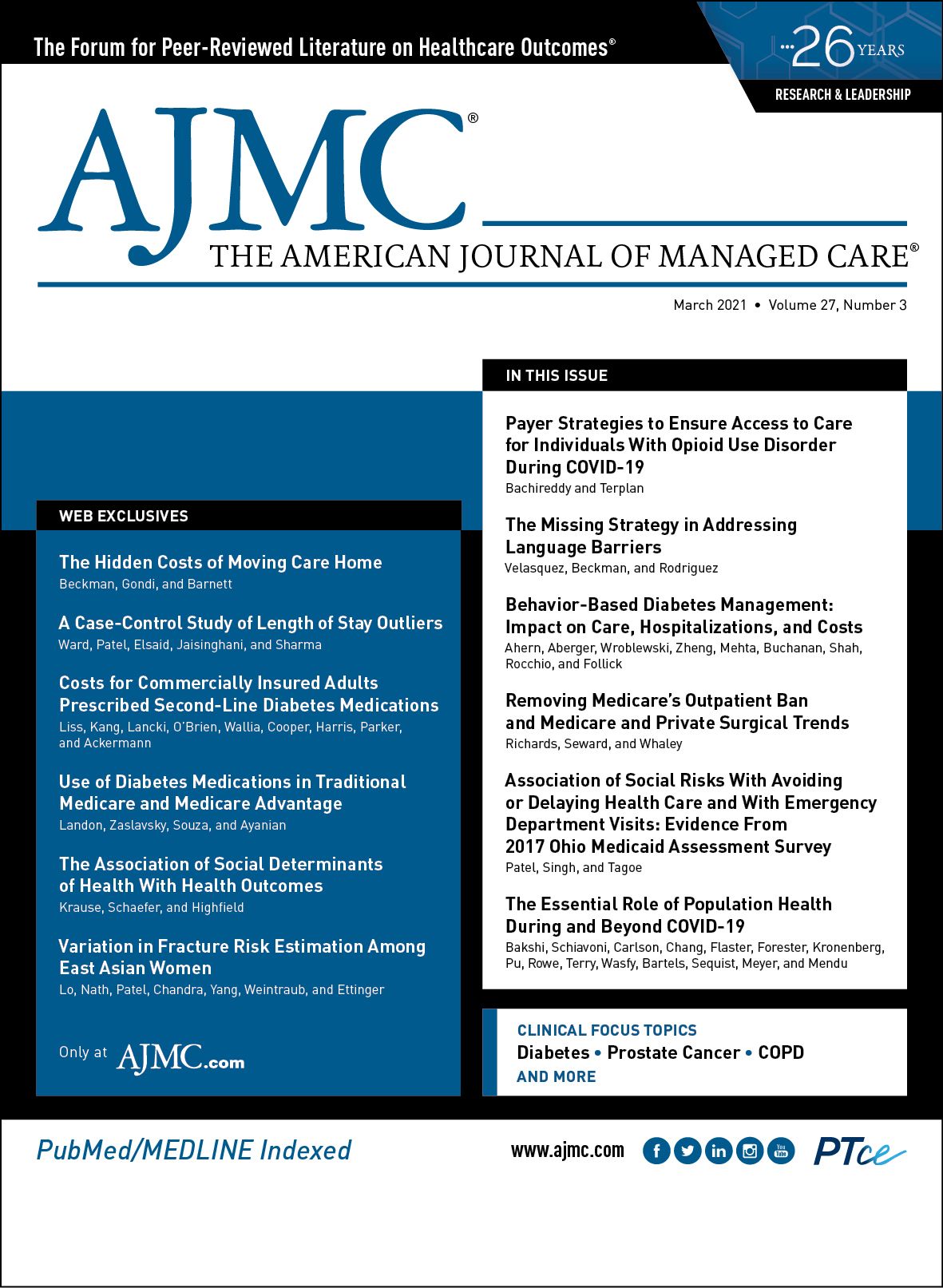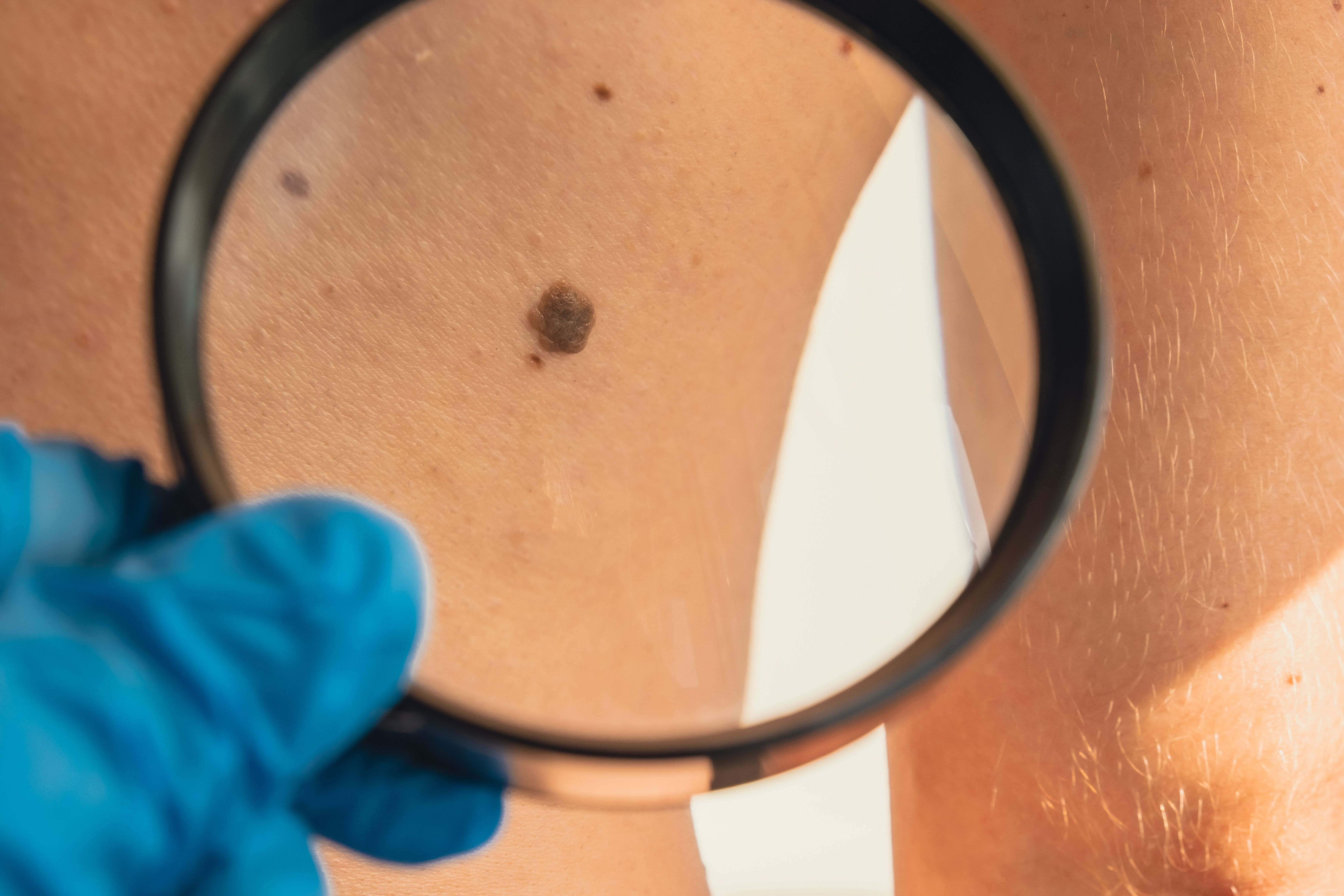Publication
Article
The American Journal of Managed Care
Payer Strategies to Ensure Access to Care for Individuals With Opioid Use Disorder During COVID-19
As the coronavirus disease 2019 (COVID-19) pandemic threatens to worsen the opioid crisis, payers must rapidly deploy policies to ensure care for individuals with opioid use disorder.
Am J Manag Care. 2021;27(3):91-92. https://doi.org/10.37765/ajmc.2021.88522
Takeaway Points
Amid the coronavirus disease 2019 pandemic, payers must deploy policies to ensure care for individuals with opioid use disorder.
- First, make it easy for patients to receive medications for opioid use disorder.
- Second, increase access to care by reimbursing virtual visits.
- Third, leverage data to identify and intervene when patients are at risk for recurrence or overdose.
- Fourth, pay providers to maintain robust networks of addiction care.
Before the coronavirus disease 2019 (COVID-19) pandemic, care for opioid use disorder (OUD) had been steadily improving through expansion of Medicaid, widespread training of physicians, and alignment of payer policies with evidence. Today, COVID-19 threatens even these modest gains. Evidence-based policies related to physical distancing have slowed the virus but have also contributed to economic recession, social isolation, and psychological distress. These same factors, together with inappropriate prescribing of opioids and criminalization of drug use, laid the foundation for our current opioid crisis.
COVID-19 has led to a reduction in ambulatory care in parts of the United States due to physical distancing requirements, fear of transmission, lack of personal protective equipment, and staff shortages.1 Concomitant disruptions in the illicit drug supply may lead to increased overdose risk and demand for comprehensive addiction treatment. In the midst of this ongoing crisis, payers, both public and private, can and must rapidly deploy policies to ensure care for individuals with OUD. We highlight specific high-value strategies that could be quickly implemented with little additional investment in infrastructure, financing, or political will.
First, make it easy for patients to receive medications for OUD (MOUD), including methadone, buprenorphine, and naltrexone. Second, increase access to care by reimbursing virtual visits. Third, leverage data to identify and intervene when patients are at risk for recurrence or overdose. Fourth, pay providers to maintain robust networks of addiction care.
Reduce Barriers to MOUD
Behavioral science demonstrates that choice architecture plays an important role in our decisions. Through utilization and network management techniques, payers design a system for providers and patients to navigate. Ideally, that system nudges us toward high-value care. MOUD are lifesaving, reduce health care and criminal justice system costs, reduce transmission of infectious disease, and increase engagement in primary and preventive care.2 Buprenorphine merits special attention because it is safe and effective and can be prescribed in office-based settings with fewer regulations compared with methadone. As a first step, payers can immediately remove co-pays, prior authorization, dose limits, in-network restrictions, counseling, and other requirements that are often obstacles to receiving buprenorphine.3 Some argue that these policies may lead to increased diversion and misuse. In practice, expanded access to buprenorphine reduces diversion and misuse because they occur commonly among individuals seeking relief from withdrawal.2 Compared with buprenorphine monotherapy, buprenorphine-naloxone is associated with lower rates of misuse.2 Mark et al demonstrate that among Medicare beneficiaries, removal of prior authorization for buprenorphine-naloxone doubled treatment rates and significantly reduced emergency department (ED) visits and hospitalizations.4 Ultimately, the lifesaving benefits of expanded access to buprenorphine far outweigh the associated risks.
Pay for Virtual OUD Care
The past year has seen an explosion in virtual care across the country as payers, including Medicare and state Medicaid programs, have loosened restrictions on telehealth. Telehealth, including synchronous audiovisual and audio-only modalities of care, has the potential to rapidly scale addiction care to patients across the country. Pre–COVID-19 federal regulation allowed for prescribing of MOUD over audiovisual platforms only to patients with whom physicians had a preexisting relationship. Emergency federal regulations now allow for buprenorphine prescribing for new patients via audiovisual and audio-only platforms.5
Limited evidence suggests that virtual OUD care is as effective as in-person care.6 Pre–COVID-19, only a minority of individuals with OUD were accessing evidence-based and lifesaving treatment. In a time of social distancing, limited personal protective equipment, and transportation barriers, payment and delivery of telehealth is imperative to ensuring access to care. Because many patients do not have reliable access to broadband connection or smartphones, audio-only visits must be reimbursed as well.
The critical and urgent need for virtual OUD care during the COVID-19 crisis has outpaced our understanding of how best to deliver this care. Important questions remain, including which patients are most appropriate for virtual OUD care, how to monitor recurrence remotely, how to ensure privacy in the home, and the cost-effectiveness of virtual care. To answer these questions, payers must work with providers and policy makers while balancing the core principles of equity, access, quality, and cost. During the COVID-19 crisis, payers should commit to reimbursing telehealth at parity with in-person visits to encourage rapid provider adoption of virtual care.
Leverage Real-time Data for Targeted Outreach at Vulnerable Moments
Advances in informatics allow payers to receive real-time data to identify individuals with OUD who are vulnerable to recurrence and overdose. For example, in Virginia Medicaid, payers leverage pharmacy data to track interruptions in MOUD receipt, particularly during the first month of treatment. Patients with a greater than 7-day interruption in MOUD are contacted, encouraged to continue MOUD, and provided with home delivery of medications if transportation is a barrier. Similarly, through the state’s health information exchange, payers receive real-time alerts if a patient presents to the ED with a diagnosis related to OUD, which triggers outreach from a care coordinator. Payers across the country can leverage their pharmacy and ED data to identify when individuals with OUD may be most vulnerable and provide outreach to them.
Pay Providers to Maintain Robust Networks of Addiction Care
Many addiction treatment providers operate in a fee-for-service environment with only a few weeks of financial reserves. Even short-term reductions in visits threaten practice financial viability and, ultimately, access to care. Across the country, addiction treatment providers are furloughing or laying off employees and limiting service hours. Although the federal government has implemented payment policies to support the financial viability of health care providers, including small business loans through the Paycheck Protection Program; emergency funds to hospitals through the Coronavirus Aid, Relief, and Economic Security Act; and advance payments to providers proportional to prior Medicare billing, these measures are insufficient. Medicare, for example, covers only 14% of individuals with OUD.7 If there is no further action, more addiction treatment providers will have to close their doors. The reduction in billed visits means that payers now have a substantial amount of dollars to direct to and support an adequate network of addiction treatment providers. They can deploy advance or retainer payments on a per-member-per-month basis and tie those payments to basic quality indicators, such as receipt of MOUD and retention in care. Without a more resilient health care financing model, our already limited network of addiction treatment providers will be further devastated, resulting in significant harm just when those with OUD need care the most.
Conclusions
The most important question for us to ask is what happens if we do nothing. Empirical and observational evidence suggests that economic and psychological distress combined with social isolation and reduced health care access can have deadly consequences for individuals with OUD. The strategies outlined in this article can be implemented rapidly by all payers to ensure that the COVID-19 crisis does not worsen the opioid crisis. We failed to act early enough to forestall the opioid crisis. Today, we have the opportunity to apply lessons from the past to limit damage in the future. The lives of our patients, families, and communities depend on it.
Author Affiliations: Virginia Department of Medical Assistance Services (CB, MT), Richmond, VA; Virginia Commonwealth University (CB), Richmond, VA; Leonard Davis Institute of Health Economics, University of Pennsylvania (CB), Philadelphia, PA; Friends Research Institute (MT), Baltimore, MD.
Source of Funding: None.
Author Disclosures: Dr Terplan is employed as the Addiction Medicine Specialist for Virginia Medicaid. Dr Bachireddy reports no relationship or financial interest with any entity that would pose a conflict of interest with the subject matter of this article.
Authorship Information: Concept and design (CB, MT); drafting of the manuscript (CB, MT); and critical revision of the manuscript for important intellectual content (CB, MT).
Address Correspondence to: Chethan Bachireddy, MD, MSc, Department of Internal Medicine, Virginia Commonwealth University School of Medicine, 1101 E Marshall St, Richmond, VA 23298. Email: chethan.bachireddy@vcuhealth.org.
REFERENCES
1. Mehrotra A, Chernew M, Linetsky D, Hatch H, Cutler D. The impact of the COVID-19 pandemic on outpatient visits: a rebound emerges. The Commonwealth Fund. May 19, 2020. Accessed May 27, 2020. https://www.commonwealthfund.org/publications/2020/apr/impact-covid-19-outpatient-visits
2. National Academies of Sciences, Engineering, and Medicine. Medications for Opioid Use Disorder Save Lives. The National Academies Press; 2019.
3. Martin SA, Chiodo LM, Bosse JD, Wilson A. The next stage of buprenorphine care for opioid use disorder. Ann Intern Med. 2019;170(11):821-822. doi:10.7326/L19-0145
4. Mark TL, Parish WJ, Zarkin GA. Association of formulary prior authorization policies with buprenorphine-naloxone prescriptions and hospital and emergency department use among Medicare beneficiaries. JAMA Netw Open. 2020;3(4):e203132. doi:10.1001/jamanetworkopen.2020.3132
5. FAQs: provision of methadone and buprenorphine for the treatment of opioid use disorder in the COVID-19 emergency. Substance Abuse and Mental Health Services Administration. Updated April 21, 2020. Accessed May 9, 2020. https://www.samhsa.gov/sites/default/files/faqs-for-oud-prescribing-and-dispensing.pdf
6. Lin AL, Casteel D, Shigekawa E, Weyrich MS, Roby DH, McMenamin SB. Telemedicine-delivered treatment interventions for substance use disorders: a systematic review. J Subst Abuse Treat. 2019;101:38-49. doi:10.1016/j.jsat.2019.03.007
7. Harris SJ, Abraham AJ, Andrews CM, Yarbrough CR. Gaps in access to opioid use disorder treatment for Medicare beneficiaries. Health Aff (Millwood). 2020;39(2):233-237. doi:10.1377/hlthaff.2019.00309







